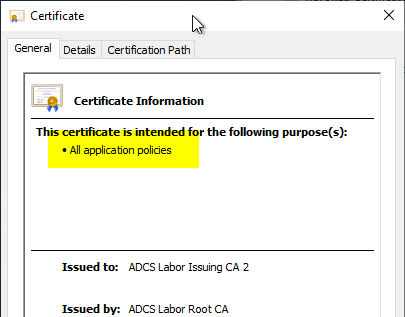Below is a guide to configuring a web server template with recommended settings.
Continue reading „Konfigurieren einer Secure Socket Layer (SSL) Zertifikatvorlage für Web Server“Category: Certificate usage
Allowed Relative Distinguished Names (RDNs) in the Subject of Issued Certificates
In principle, the RFC 5280 the use of arbitrary strings in the subject string of a certificate. Common fields in the standard are X.520 described. The Length restrictions are also recommended by the ITU-T. The abbreviations commonly used today are mainly taken from the RFC 4519.
However, Microsoft Active Directory Certificate Services only allows certain RDNs by default.
The following Relative Distinguished Names (RDNs) are accepted by the Active Directory Certificate Services (ADCS) certificate authority by default:
Continue reading „Erlaubte Relative Distinguished Names (RDNs) im Subject Distinguished Name (DN) ausgestellter Zertifikate“Inspect a certificate request (CSR)
Often, before submitting a certificate request to a certification authority - or before issuing the certificate - you want to verify that it contains the desired values.
The following describes how to achieve this.
Continue reading „Eine Zertifikatanforderung (CSR) inspizieren“Subsequently change the Subject Distinguished Name (DN) of a certificate request (CSR)
Sometimes it is necessary to change the Subject Distinguished Name (also called Subject, Subject DN, Applicant or Subject) of a certificate request before issuing the certificate.
Under certain circumstances, this is certainly possible, as described below.
Continue reading „Den Subject Distinguished Name (DN) einer Zertifikatanforderung (CSR) nachträglich verändern“Configuring a Certificate Template for Authentication Mechanism Assurance (AMA)
Authentication Mechanism Assurance (AMA) provides the ability to tie membership in a security group to enrollment with a smart card certificate containing a specific Object Identifier (OID).
If the user does not log in with the smartcard certificate, but with user name and password, he is also not a member of the security group.
The following describes how to generate a certificate template for use with Authentication Mechanism Assurance.
Continue reading „Konfigurieren einer Zertifikatvorlage für Authentication Mechanism Assurance (AMA)“Include the wildcard issuance policy (All Issuance Policies) in a certification authority certificate
If you install an issuing CA and do not explicitly request an issuance policy, the resulting CA certificate will not contain an issuance policy.

If you want to include the wildcard issuance policy (All Issuance Policies) in the certification authority certificate, you must proceed as follows:
Continue reading „Die Wildcard Ausstellungsrichtlinie (All Issuance Policies) in ein Zertifizierungsstellen-Zertifikat aufnehmen“Include the issuance policies for Trusted Platform (TPM) Key Attestation in a certification authority certificate.
If you install an issuing CA and do not explicitly request an issuance policy, the resulting CA certificate does not contain an issuance policy.

If you want to include the issuance policies for Trusted Platform (TPM) Key Attestation in the certification authority certificate, you must proceed as follows.
Continue reading „Die Ausstellungsrichtlinien (Issuance Policies) für Trusted Platform (TPM) Key Attestation in ein Zertifizierungsstellen-Zertifikat aufnehmen“Determine and export a Trusted Platform Module (TPM) Endorsement Certificate
If you want to use the Trusted Platform Module (TPM) key attestation, you have the option of attesting the TPM via the endorsement certificate (EkCert), among other things. The following describes how to obtain this information.
Continue reading „Ermitteln und Exportieren eines Trusted Platform Module (TPM) Endorsement Zertifikats“Determine the checksum (hash) of a Trusted Platform (TPM) Endorsement Key
If you want to use the Trusted Platform Module (TPM) key attestation, you have the option of attesting the TPM via the endorsement key (EkPub), among other things. The following describes how to obtain this information.
Continue reading „Die Prüfsumme (Hash) eines Trusted Platform (TPM) Endorsement Key ermitteln“Frequently Used Extended Key Usages and Issuance Policies
The following is a list of commonly used extended key usage and issuance policies that are used repeatedly in practice to restrict certificate authority certificates.
Continue reading „Häufig verwendete erweiterte Schlüsselverwendungen (Extended Key Usages) und Ausstellungsrichtlinien (Issuance Policies)“Logon via smartcard fails with error message "The revocation status of the authentication certificate could not be determined."
Assume the following scenario:
- A user has a Smartcard Logon certificate and logs on to the Active Directory domain with it.
- The login fails. The following error message is returned to the user's computer:
The revocation status of the authentication certificate could not be determined.Continue reading „Die Anmeldung via Smartcard schlägt fehl mit Fehlermeldung „The revocation status of the authentication certificate could not be determined.““
Renew the Registration Authority (RA) certificates for the Network Device Enrollment Service (NDES).
Once NDES has been in operation for some time (typically two years), one is faced with the challenge of renewing the Registration Authority (RA) certificates. Unfortunately, this process is not necessarily solved intuitively and is therefore described in more detail in this article.
Continue reading „Die Registration Authority (RA) Zertifikate für den Registrierungsdienst für Netzwerkgeräte (NDES) erneuern“The Network Device Enrollment Service (NDES) logs the error message "The Network Device Enrollment Service cannot retrieve one of its required certificates (0x80070057). The parameter is incorrect."
Assume the following scenario:
- An NDES server is configured on the network.
- HTTP error 500 (Internal Server Error) is reported when accessing the NDES application web page (mscep) and the NDES administration web page (certsrv/mscep_admin).
- The events no. 2 and 10 stored in the application event log:
The Network Device Enrollment Service cannot be started (0x80070057). The parameter is incorrect.
The Network Device Enrollment Service cannot retrieve one of its required certificates (0x80070057). The parameter is incorrect.Continue reading „Der Registrierungsdienst für Netzwerkgeräte (NDES) protokolliert die Fehlermeldung „The Network Device Enrollment Service cannot retrieve one of its required certificates (0x80070057). The parameter is incorrect.““
Creating a virtual smart card in a Hyper-V guest system
For test environments, it is often helpful to be able to work with smartcards. Below is a brief guide on how to set up a virtual smartcard in a Hyper-V guest using a virtualized Trusted Platform Module (TPM).
Continue reading „Erstellen einer virtuellen Smartcard in einem Hyper-V Gastsystem“Domain Controller Certificate Templates and Smartcard Logon
In order for domain controllers to process smart card logins, they need certificates that provide this function.
Continue reading „Domänencontroller-Zertifikatvorlagen und Smartcard Anmeldung“